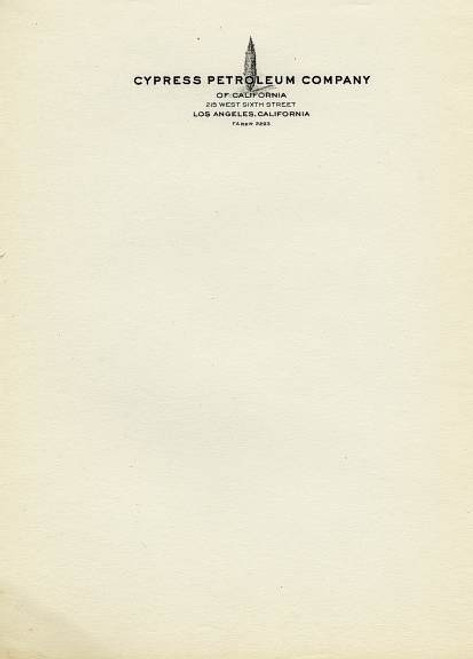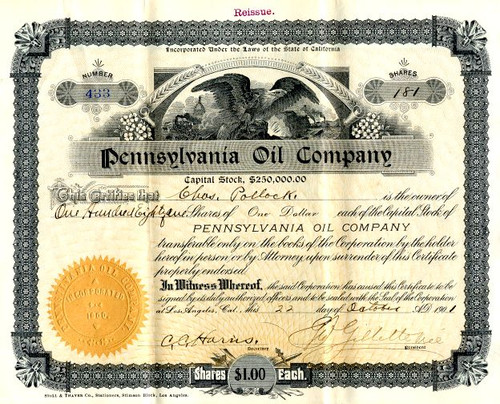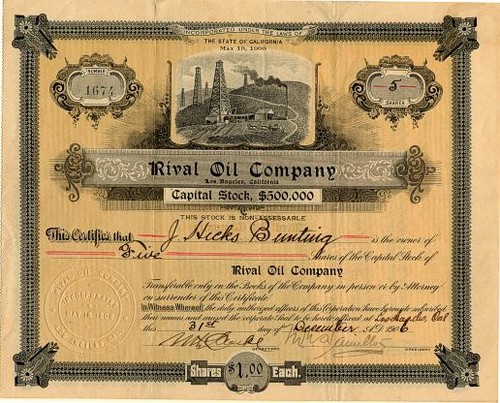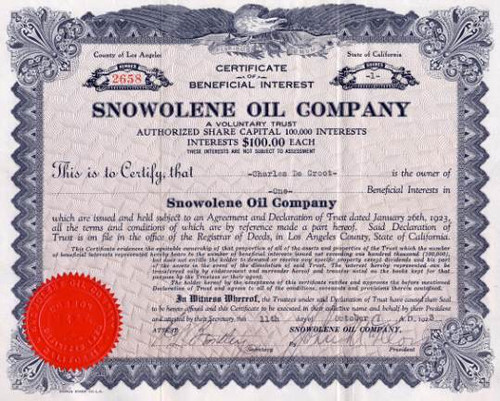Beautiful certificate from the Petroleum Development Company issued in 1900. This historic document has an ornate border around it with a vignette of an eagle and oil derreck over the embossed corporate seal. This item has the signatures of the Company's President, Edward L. Doheny and Secretary, Charles Wellborn and is over 109 years old. The certificate was issued to Edward L. Doheny and is signed by him on the left ledger page and on the verso. Punched cancellation doesn't affect any of the three Bold Doheny signatures. 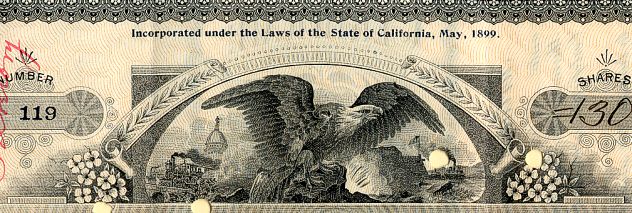
Certificate Vignette 
Doheny's Signature as President Edward Laurence Doheny (August 10, 1856 - September 8, 1935) was an Irish American oil tycoon, who in 1892, along with partner Charles A. Canfield, drilled the first successful well in the Los Angeles City oil field, setting off the petroleum boom in southern California. Formerly an unsuccessful prospector in New Mexico and the American Southwest, the Wisconsin-born Doheny became wealthy through his California oil interests, and was later also successful in the oil fields of Tampico, Mexico. During the administration of President Warren G. Harding, Doheny was implicated in the Teapot Dome Scandal and was accused of offering a $100,000 bribe to Secretary of the Interior Albert Fall in order to secure drilling rights without competitive bidding to the Elk Hills Naval Petroleum Reserve in central California. He was twice acquitted of offering the bribe that Fall was convicted of accepting. Doheny and his second wife and widow, Carrie Estelle, were noted philanthropists in Los Angeles. The character Vern Roscoe in Upton Sinclair's novel Oil (the inspiration for the 2007 film There Will Be Blood) is loosely based on Doheny. Doheny was born in Fond du Lac, Wisconsin. His family history reaches back to Ireland, from which his family fled in the wake of the Great Famine. Doheny graduated from high school at age 15 as the valedictorian of his class. Following his father's death several months after his graduation, he was employed by the U.S. Geological Survey, and in 1873 was sent to Kansas with a party surveying and subdividing the Kiowa-Comanche lands. The following year he left the Geological Survey to pursue his fortune prospecting, first in the Black Hills of South Dakota and then in Arizona Territory. By 1880 he was in the Black Mountains of southwestern New Mexico, then part of Arizona Territory, living in the rough, silver- mining town of Kingston, prospecting, mining, and buying and trading mining claims. During his time in Kingston he met two men who would play important roles in his later life--Albert Fall, the future Secretary of the Interior, and his business partner Charles A. Canfield. It was also during this time that he met and married his first wife, Carrie Louella Wilkins, on August 7, 1883. Doheny and Canfield together worked the former's Mount Chief Mine with little success, and thus in 1886 Canfield prospected further in the Kingston area, leasing and developing with great success the Comstock Mine, not to be confused with the Comstock Lode of Virginia City, Nevada. Doheny declined to join him in this venture, and whereas Canfield made a small fortune from it, Doheny was reduced eventually to doing odd jobs to support his family. In the Spring of 1891, Doheny left New Mexico with his wife and daughter, and moved to Los Angeles, attracted by Canfield's success in Los Angeles real estate. Canfield had previously left New Mexico with $110,000 in cash from his Comstock Mine venture, a sum that he parlayed into extensive real estate holdings during the Los Angeles boom of the later 1880s. With the collapse of the speculative fever, Canfield lost his wealth and land holdings and, by the time Doheny arrived in Los Angeles in 1891, was deeply in debt. Briefly the two men tried their prospecting luck in San Diego, forming there the Pacific Gold and Silver Extracting Company, but returned to Los Angeles soon thereafter without achieving success. By 1892, Doheny was so poor he could not afford to pay for his boarding room. While in Los Angeles, Doheny found out that there was pitch beneath the soil. Doheny obtained a lease near downtown with $400 in financing from friend Charles Canfield, who had made some money from the mining industry. A poor man, Doheny dug a well with picks and shovels, looking for pitch, which could be mixed with soil to extract petroleum. When the well reached a depth of 150 feet (46 m) Doheny devised a drilling system involving a eucalyptus tree trunk. The well, when completed in 1903, produced 40 barrels per day (6.4 mł/d). In May, 1899, Edward Doheny organized the Petroleum Development Co., and bought lands in Kern County, about eight miles from Bakersfield, and in San Luis Obispo County, near Arroyo Grande, and this company became in a short time the heaviest producer and shipper in Kern County, and supplied thé Santa Fe Railway with all the oil it needed. Doheny and Canfield soon made a fortune by drilling in the area and selling the oil to nearby factories. Later, they helped spur the California oil boom of the early 1900s by convincing railroads to switch from coal to oil as power for their locomotives. Doheny would later form the PanAmerican Petroleum and Transport Company. The company owned 600,000 acres (2400 km²) of land in Mexico worth about $50 million. It would later become the Mexican Petroleum Company with an additional 800,000 acres (3200 km²) in Mexico in October 1919. He would later step down from chairmanship and become head of Pan American Western Petroleum Company. Doheny also made his mark in the 1916 Presidential election by wagering on Woodrow Wilson to be the victor. A common practice at the time, this bet made him $500,000 richer. Doheny took his yacht, the Casiana (named after his first major producing oil well in Mexico, the Casiana No. 7), to Martinique to pick up a friend's brother who worked as a farmer on the island and who was seriously ill. Doheny brought him back to New York; the steam yacht was able to make the trip in only 5 days. Doheny contributed money to foundations. He helped fund the construction of St. Vincent de Paul Church. He also donated $1.1 million in 1932 to USC to build the Edward L. Doheny, Jr., Memorial Library. His second wife, Carrie Estelle Doheny donated her rare book collection St. John's Seminary in Camarillo, CA. Doheny is also famous for another of his gifts -- the wedding gift of Greystone Mansion to his son, Edward (Ned) L. Doheny, Jr. He built the $3,188,000 house in 1928. Doheny, Sr., had a mansion in the historical West Adams district of Los Angeles and in Chester Place, a gated community of Victorian mansions which Doheny developed. It was built in 1899 in the French Gothic architectural style. This 3-story, 22-room Doheny Mansion was damaged in the 1933 earthquake but was repaired, and is now part of Mount St. Mary's College's campus, where it houses college departments, docent tours, and chamber music concerts by The Da Camera Society. The Doheny family also owned a great deal of coastal land in Dana Point, CA, which was donated for Doheny State Beach and donated the funds for the construction of the original site of St. Edward the Confessor Roman Catholic Church, which has since moved to a bluff-top location overlooking Doheny State Beach. The original building is now home to San Felipe de Jesus Roman Catholic Church. The Doheny Estate has donated money for the construction of buildings and residence halls to Loyola Marymount University and the land for one of the campuses of Mount Saint Mary's College in Los Angeles. Doheny's reputation was somewhat tainted by a bribe paid to the Secretary of the Interior, Albert B. Fall. The "gift" of $100,000 was made in connection with obtaining a lease of 32,000 acres (130 km²) of government owned land used for the Elk Hills Naval Petroleum Reserve near Taft, California. The resulting scandal broke soon after that over similar bribes Fall accepted for leasing Teapot Dome in Wyoming. Doheny faced criminal charges over the incident but was cleared of all charges, including murder. The scandal is also the inspiration for Upton Sinclair's novel, Oil!, based in part on Doheny's life. He died on September 8, 1935 of unspecified causes. His funeral was in St. Vincent's Church in Los Angeles, a church that he built. Doheny Drive in West Hollywood and Beverly Hills are named after him. History from Wikipedia and OldCompanyResearch.com (old stock certificate research service).
The following was published by THE LOS ANGELES EXAMINER in 1912: PROGRESSIVE MEN OF THE SOUTHWEST, WHO HAVE HELPED IN THE DEVELOPMENT AND HISTORY MAKING OF THIS WONDERFUL COUNTRY DOHENY, EDWARD LAWRENCE, Oil Investments, Los Angeles,. Cal., was born In Fond du Lac, Wis., in 1856. His family consists of Mrs. Carrie Estelle (Betzold) Doheny, and a son, E. L. Doheny, Jr., who has reached his maturity. He attended the public schools of his native city and was graduated from its high school in 1872. Immediately after leaving school he entered the employ of the U. S. Government in the survey department, and his work carried him to the West. He first went to Kansas, in July, 1872, to assist in surveying government lands, and the next year to New Mexico in a similar capacity. He then returned to Kansas, and after a brief period went to the Indian Territory. There he assisted in subdividing the Kiowa and Comanche Indian reservations, in 1873, 1874 and 1875. In 1876, Mr. Doheny, hardly more than a boy, was seized with the mining fever and made for the Black Hills in search of gold. The land was still Indian territory, however, and he, like others, was prevented from prospecting by the Federal Government. So he turned his footsteps toward the great San Juan country, in Southwestern Colorado. Winter set in early, and again the prospector was frustrated in his quest. Nothing daunted, he joined three other determined prospectors, and with burros they set out for the great Southwest. They started from Silver- ton, Colo., and went to Prescott, Ariz. Then began one of the most exciting and picturesque periods in his career. For the next fourteen years he was a gold hunter in Arizona and New Mexico, and the story of his life there is part of the thrilling early history of those territories. His efforts at mining in the Bradshaw, Cave Creek, Tonto Basin, Globe and Tombstone districts are a part of the mining history of the Southwest. He was a pioneer in all of these booms and in three of them was one of the discoverers. While prospecting Mr. Doheny was also improving himself by the study of law. He was admitted to the bar and practiced for a year or more; then went back to mining. He moved to San Bernardino County, Cal., and resumed his mining operations in the desert of that county. In this he was associated with C. A. Can- field, his partner in former mining enterprises in New Mexico, and J. A. Chanslor. The desert did not yield the gold the three expected, and at the end of two years they began to look for new fields. Mr. Doheny and his partners went to Los Angeles, Cal., and there he became the chief figure of a group of oil men whose operations rival those of the few world combinations. In California, and in Mexico especially, they own oil fields the production of which far exceeds that of the greatest fields ever discovered elsewhere. Mr. Doheny, In company with old partners of the mining days, all then with little ready money, began to drill for oil in Los Angeles City, Nov. 4, 1892, at the corner of Patton and West State streets. This was the beginning of the Los Angeles fields. wealth. He discovered and opened up the oil fields of Orange County, in 1897, and it was there that at last his operations began to loom large. In May, 1899, he organized the Petroleum Development Co., and bought lands in Kern County, about eight miles from Bakersfield, and in San Luis Obispo County, near Arroyo Grande, and this company became in a short time the heaviest producer and shipper in Kern County, and supplied thé Santa Fe Railway with all the oil it needed. In 1902, with Mr. C. A. Canfield, he organized the Mexican Petroleum Co. of California, to operate in Mexico, and entered upon a most tremendous oil enterprise. The oilfields of the Mexican Petroleum Co., and of the Huasteca Petroleum Co., both subsidiary corporations of the Mexican Petroleum Co., Ltd., are located on the eastern slope of Mexico, west and south of Tampico. In the production of flowing wells, the extent of proven territory, and the scale on which the property is being developed they easily lead all other fields. Two wells, known as No. 6 and No. 7, Casiano, are among the greatest gushers ever tapped. Two parallel pipe lines, one 93 miles long and the other 70 miles, have been built to the Port of Tampico, on the Gldf of Mexico. Concrete basins have been built holding 2,500,000 barrels of oil, and steel tanks holding an additional 5,000,000 barrels, and even this is not enough. More tanks are building at Terminal and at Tankvllle, across the Pannas river from Tampico. Mr. Doheny's holdings are concentrated chiefly in the following companies, of which he Is President: Mexican Petroleum Co., Ltd., Mexican Petroleum Co., Huasteca Petroleum Co., American Petroleum Co., American Oilfields Co., Mexican National Gas Co., and the Mexican Paving Co., of which he is general manager. He is a large individual property owner in California and Mexico. His home is in Los Angeles, where he has lived for twenty years. He has joined his neighbors in various movements for civic benefit, and has gratified his own and his neighbors' tastes by bringing to his gardens what is perhaps the largest private collection extant of tropical -- mostly Mexican -- plants, especially palms, the major part of which must be kept under glass. These have required hothouses, which have been repeatedly enlarged as the collection has grown. He has been credited with great luck, and with luck chiefly in his business affairs, but his associates say this is a false and unfair estimate. He started life with a mind of extreme keenness, of logical methods, with a capacity for mathematical calculation that suggests lightning, and with a wholesome impatience at delay, circumlocution and laziness. Added to this endowment, and that of common bedrock honesty that he got from his superior mother, was an unusually thorough training in geology and higher mathematics. His knowledge in these branches of science he has used with telling effect ever since. Two other circumstances have contributed In a large way to his success -- one, his capacity for the selection of his field lieutenants, and the other the unbroken correctness of his personal habits. His brain has never once felt the effect of alcohol or tobacco, and his use of tea and coffee has been temperate. The human side of him is shown in his care of a lot of worthy former associates of the mining days who have been less fortunate than he; and he would be annoyed by any profusion of thanks for these or any other benefactions.

Certificate Vignette

Doheny's Signature as President
The following was published by THE LOS ANGELES EXAMINER in 1912: PROGRESSIVE MEN OF THE SOUTHWEST, WHO HAVE HELPED IN THE DEVELOPMENT AND HISTORY MAKING OF THIS WONDERFUL COUNTRY DOHENY, EDWARD LAWRENCE, Oil Investments, Los Angeles,. Cal., was born In Fond du Lac, Wis., in 1856. His family consists of Mrs. Carrie Estelle (Betzold) Doheny, and a son, E. L. Doheny, Jr., who has reached his maturity. He attended the public schools of his native city and was graduated from its high school in 1872. Immediately after leaving school he entered the employ of the U. S. Government in the survey department, and his work carried him to the West. He first went to Kansas, in July, 1872, to assist in surveying government lands, and the next year to New Mexico in a similar capacity. He then returned to Kansas, and after a brief period went to the Indian Territory. There he assisted in subdividing the Kiowa and Comanche Indian reservations, in 1873, 1874 and 1875. In 1876, Mr. Doheny, hardly more than a boy, was seized with the mining fever and made for the Black Hills in search of gold. The land was still Indian territory, however, and he, like others, was prevented from prospecting by the Federal Government. So he turned his footsteps toward the great San Juan country, in Southwestern Colorado. Winter set in early, and again the prospector was frustrated in his quest. Nothing daunted, he joined three other determined prospectors, and with burros they set out for the great Southwest. They started from Silver- ton, Colo., and went to Prescott, Ariz. Then began one of the most exciting and picturesque periods in his career. For the next fourteen years he was a gold hunter in Arizona and New Mexico, and the story of his life there is part of the thrilling early history of those territories. His efforts at mining in the Bradshaw, Cave Creek, Tonto Basin, Globe and Tombstone districts are a part of the mining history of the Southwest. He was a pioneer in all of these booms and in three of them was one of the discoverers. While prospecting Mr. Doheny was also improving himself by the study of law. He was admitted to the bar and practiced for a year or more; then went back to mining. He moved to San Bernardino County, Cal., and resumed his mining operations in the desert of that county. In this he was associated with C. A. Can- field, his partner in former mining enterprises in New Mexico, and J. A. Chanslor. The desert did not yield the gold the three expected, and at the end of two years they began to look for new fields. Mr. Doheny and his partners went to Los Angeles, Cal., and there he became the chief figure of a group of oil men whose operations rival those of the few world combinations. In California, and in Mexico especially, they own oil fields the production of which far exceeds that of the greatest fields ever discovered elsewhere. Mr. Doheny, In company with old partners of the mining days, all then with little ready money, began to drill for oil in Los Angeles City, Nov. 4, 1892, at the corner of Patton and West State streets. This was the beginning of the Los Angeles fields. wealth. He discovered and opened up the oil fields of Orange County, in 1897, and it was there that at last his operations began to loom large. In May, 1899, he organized the Petroleum Development Co., and bought lands in Kern County, about eight miles from Bakersfield, and in San Luis Obispo County, near Arroyo Grande, and this company became in a short time the heaviest producer and shipper in Kern County, and supplied thé Santa Fe Railway with all the oil it needed. In 1902, with Mr. C. A. Canfield, he organized the Mexican Petroleum Co. of California, to operate in Mexico, and entered upon a most tremendous oil enterprise. The oilfields of the Mexican Petroleum Co., and of the Huasteca Petroleum Co., both subsidiary corporations of the Mexican Petroleum Co., Ltd., are located on the eastern slope of Mexico, west and south of Tampico. In the production of flowing wells, the extent of proven territory, and the scale on which the property is being developed they easily lead all other fields. Two wells, known as No. 6 and No. 7, Casiano, are among the greatest gushers ever tapped. Two parallel pipe lines, one 93 miles long and the other 70 miles, have been built to the Port of Tampico, on the Gldf of Mexico. Concrete basins have been built holding 2,500,000 barrels of oil, and steel tanks holding an additional 5,000,000 barrels, and even this is not enough. More tanks are building at Terminal and at Tankvllle, across the Pannas river from Tampico. Mr. Doheny's holdings are concentrated chiefly in the following companies, of which he Is President: Mexican Petroleum Co., Ltd., Mexican Petroleum Co., Huasteca Petroleum Co., American Petroleum Co., American Oilfields Co., Mexican National Gas Co., and the Mexican Paving Co., of which he is general manager. He is a large individual property owner in California and Mexico. His home is in Los Angeles, where he has lived for twenty years. He has joined his neighbors in various movements for civic benefit, and has gratified his own and his neighbors' tastes by bringing to his gardens what is perhaps the largest private collection extant of tropical -- mostly Mexican -- plants, especially palms, the major part of which must be kept under glass. These have required hothouses, which have been repeatedly enlarged as the collection has grown. He has been credited with great luck, and with luck chiefly in his business affairs, but his associates say this is a false and unfair estimate. He started life with a mind of extreme keenness, of logical methods, with a capacity for mathematical calculation that suggests lightning, and with a wholesome impatience at delay, circumlocution and laziness. Added to this endowment, and that of common bedrock honesty that he got from his superior mother, was an unusually thorough training in geology and higher mathematics. His knowledge in these branches of science he has used with telling effect ever since. Two other circumstances have contributed In a large way to his success -- one, his capacity for the selection of his field lieutenants, and the other the unbroken correctness of his personal habits. His brain has never once felt the effect of alcohol or tobacco, and his use of tea and coffee has been temperate. The human side of him is shown in his care of a lot of worthy former associates of the mining days who have been less fortunate than he; and he would be annoyed by any profusion of thanks for these or any other benefactions.




